Question Number 86703 by lémùst last updated on 30/Mar/20
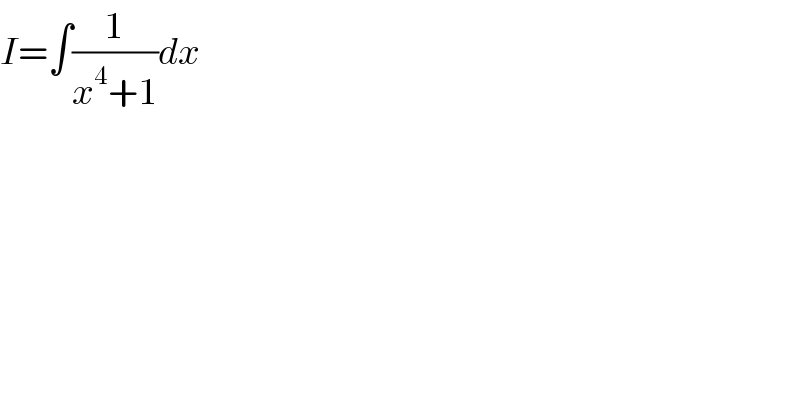
$${I}=\int\frac{\mathrm{1}}{{x}^{\mathrm{4}} +\mathrm{1}}{dx} \\ $$
Commented by john santu last updated on 30/Mar/20

$$\mathrm{x}^{\mathrm{4}} +\mathrm{1}\:=\:\left(\mathrm{x}^{\mathrm{2}} −\mathrm{i}\right)\left(\mathrm{x}^{\mathrm{2}} +\mathrm{i}\right) \\ $$$$=\:\left(\mathrm{x}+\sqrt{\mathrm{i}}\right)\left(\mathrm{x}−\sqrt{\mathrm{i}}\right)\left(\mathrm{x}^{\mathrm{2}} +\mathrm{i}\right) \\ $$$$\frac{\mathrm{1}}{\mathrm{x}^{\mathrm{4}} +\mathrm{1}}\:=\:\frac{\mathrm{a}}{\mathrm{x}+\sqrt{\mathrm{i}}}\:+\frac{\mathrm{b}}{\mathrm{x}−\sqrt{\mathrm{i}}}\:+\:\frac{\mathrm{cx}+\mathrm{d}}{\mathrm{x}^{\mathrm{2}} +\mathrm{i}}\: \\ $$
Commented by mathmax by abdo last updated on 30/Mar/20
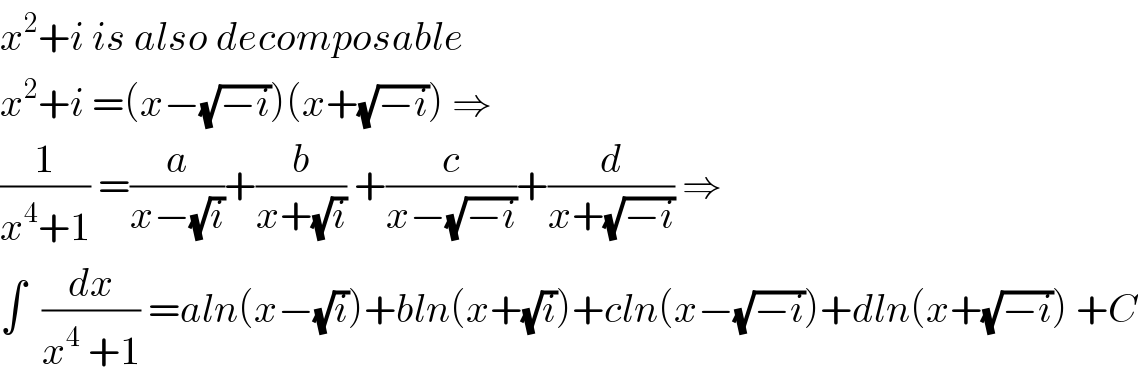
$${x}^{\mathrm{2}} +{i}\:{is}\:{also}\:{decomposable}\: \\ $$$${x}^{\mathrm{2}} +{i}\:=\left({x}−\sqrt{−{i}}\right)\left({x}+\sqrt{−{i}}\right)\:\Rightarrow \\ $$$$\frac{\mathrm{1}}{{x}^{\mathrm{4}} +\mathrm{1}}\:=\frac{{a}}{{x}−\sqrt{{i}}}+\frac{{b}}{{x}+\sqrt{{i}}}\:+\frac{{c}}{{x}−\sqrt{−{i}}}+\frac{{d}}{{x}+\sqrt{−{i}}}\:\Rightarrow \\ $$$$\int\:\:\frac{{dx}}{{x}^{\mathrm{4}} \:+\mathrm{1}}\:={aln}\left({x}−\sqrt{{i}}\right)+{bln}\left({x}+\sqrt{{i}}\right)+{cln}\left({x}−\sqrt{−{i}}\right)+{dln}\left({x}+\sqrt{−{i}}\right)\:+{C} \\ $$
Commented by Ar Brandon last updated on 30/Mar/20
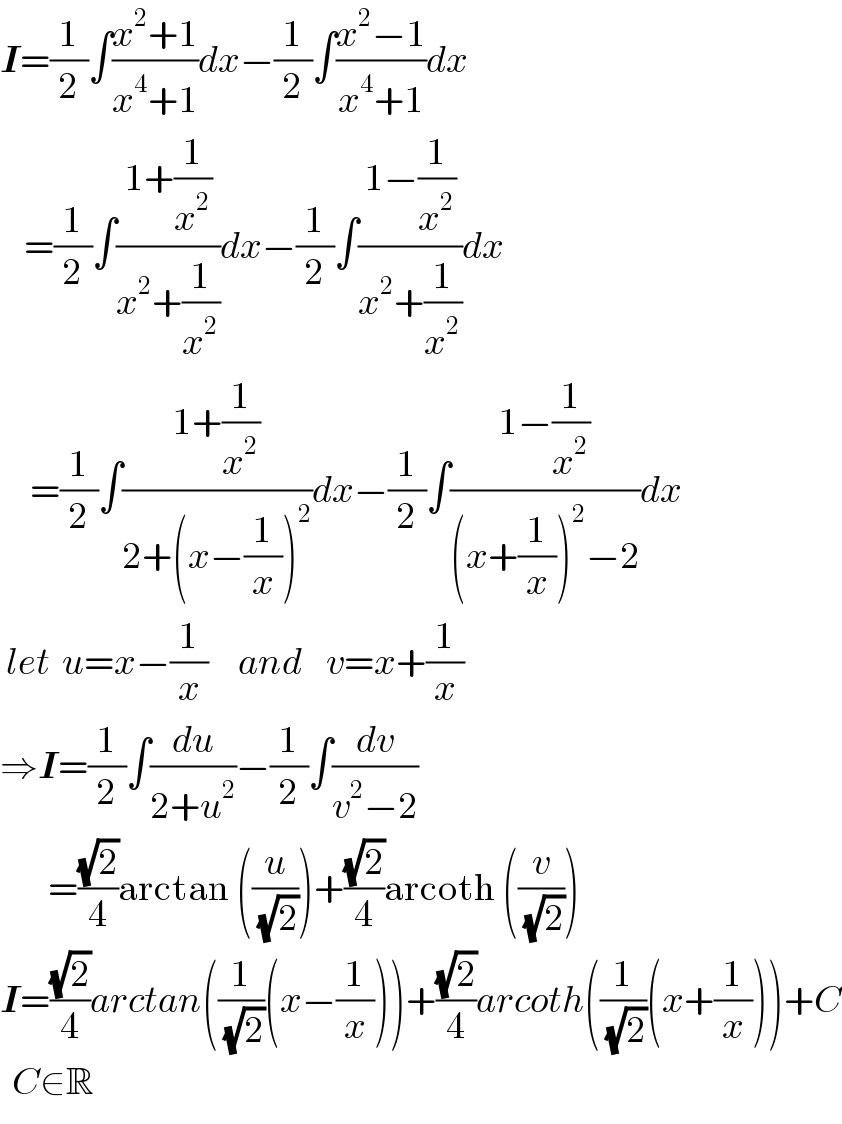
$$\boldsymbol{{I}}=\frac{\mathrm{1}}{\mathrm{2}}\int\frac{{x}^{\mathrm{2}} +\mathrm{1}}{{x}^{\mathrm{4}} +\mathrm{1}}{dx}−\frac{\mathrm{1}}{\mathrm{2}}\int\frac{{x}^{\mathrm{2}} −\mathrm{1}}{{x}^{\mathrm{4}} +\mathrm{1}}{dx} \\ $$$$\:\:\:\:=\frac{\mathrm{1}}{\mathrm{2}}\int\frac{\mathrm{1}+\frac{\mathrm{1}}{{x}^{\mathrm{2}} }}{{x}^{\mathrm{2}} +\frac{\mathrm{1}}{{x}^{\mathrm{2}} }}{dx}−\frac{\mathrm{1}}{\mathrm{2}}\int\frac{\mathrm{1}−\frac{\mathrm{1}}{{x}^{\mathrm{2}} }}{{x}^{\mathrm{2}} +\frac{\mathrm{1}}{{x}^{\mathrm{2}} }}{dx} \\ $$$$\:\:\:\:\:=\frac{\mathrm{1}}{\mathrm{2}}\int\frac{\mathrm{1}+\frac{\mathrm{1}}{{x}^{\mathrm{2}} }}{\mathrm{2}+\left({x}−\frac{\mathrm{1}}{{x}}\right)^{\mathrm{2}} }{dx}−\frac{\mathrm{1}}{\mathrm{2}}\int\frac{\mathrm{1}−\frac{\mathrm{1}}{{x}^{\mathrm{2}} }}{\left({x}+\frac{\mathrm{1}}{{x}}\right)^{\mathrm{2}} −\mathrm{2}}{dx} \\ $$$$\:{let}\:\:{u}={x}−\frac{\mathrm{1}}{{x}}\:\:\:\:\:{and}\:\:\:\:{v}={x}+\frac{\mathrm{1}}{{x}} \\ $$$$\Rightarrow\boldsymbol{{I}}=\frac{\mathrm{1}}{\mathrm{2}}\int\frac{{du}}{\mathrm{2}+{u}^{\mathrm{2}} }−\frac{\mathrm{1}}{\mathrm{2}}\int\frac{{dv}}{{v}^{\mathrm{2}} −\mathrm{2}} \\ $$$$\:\:\:\:\:\:\:\:=\frac{\sqrt{\mathrm{2}}}{\mathrm{4}}\mathrm{arctan}\:\left(\frac{{u}}{\:\sqrt{\mathrm{2}}}\right)+\frac{\sqrt{\mathrm{2}}}{\mathrm{4}}\mathrm{arcoth}\:\left(\frac{{v}}{\:\sqrt{\mathrm{2}}}\right) \\ $$$$\boldsymbol{{I}}=\frac{\sqrt{\mathrm{2}}}{\mathrm{4}}{arctan}\left(\frac{\mathrm{1}}{\:\sqrt{\mathrm{2}}}\left({x}−\frac{\mathrm{1}}{{x}}\right)\right)+\frac{\sqrt{\mathrm{2}}}{\mathrm{4}}{arcoth}\left(\frac{\mathrm{1}}{\:\sqrt{\mathrm{2}}}\left({x}+\frac{\mathrm{1}}{{x}}\right)\right)+{C} \\ $$$$\:\:{C}\in\mathbb{R} \\ $$
Commented by lémùst last updated on 31/Mar/20

$${thanks} \\ $$
Commented by lémùst last updated on 31/Mar/20

$${I}\:{don}'{t}\:{understand} \\ $$
Commented by Ar Brandon last updated on 31/Mar/20

$$\mathscr{A}{t}\:{what}\:{level}? \\ $$
Answered by MJS last updated on 30/Mar/20
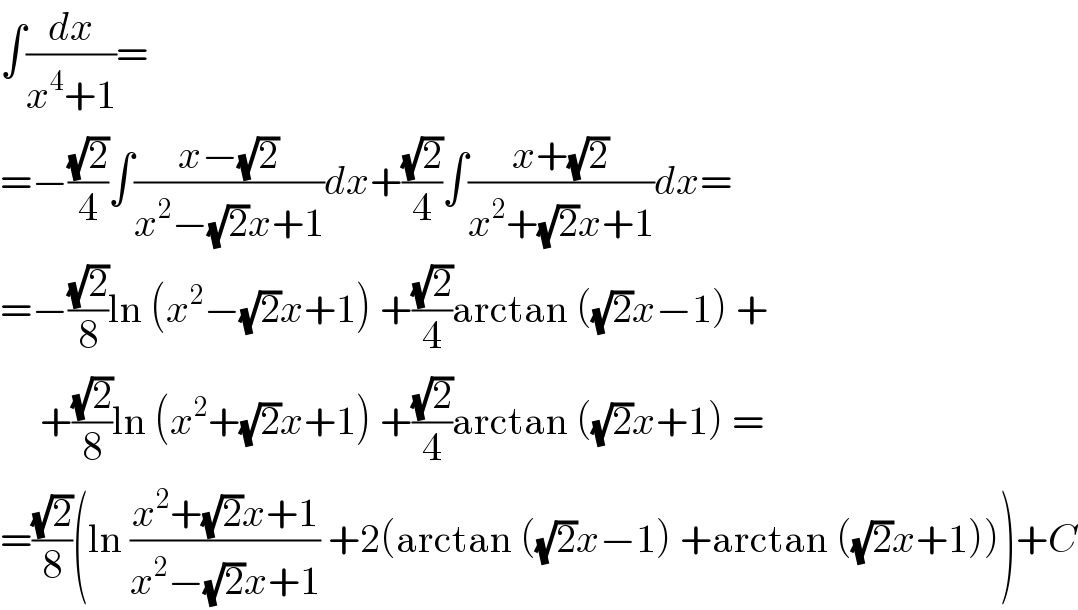
$$\int\frac{{dx}}{{x}^{\mathrm{4}} +\mathrm{1}}= \\ $$$$=−\frac{\sqrt{\mathrm{2}}}{\mathrm{4}}\int\frac{{x}−\sqrt{\mathrm{2}}}{{x}^{\mathrm{2}} −\sqrt{\mathrm{2}}{x}+\mathrm{1}}{dx}+\frac{\sqrt{\mathrm{2}}}{\mathrm{4}}\int\frac{{x}+\sqrt{\mathrm{2}}}{{x}^{\mathrm{2}} +\sqrt{\mathrm{2}}{x}+\mathrm{1}}{dx}= \\ $$$$=−\frac{\sqrt{\mathrm{2}}}{\mathrm{8}}\mathrm{ln}\:\left({x}^{\mathrm{2}} −\sqrt{\mathrm{2}}{x}+\mathrm{1}\right)\:+\frac{\sqrt{\mathrm{2}}}{\mathrm{4}}\mathrm{arctan}\:\left(\sqrt{\mathrm{2}}{x}−\mathrm{1}\right)\:+ \\ $$$$\:\:\:\:\:+\frac{\sqrt{\mathrm{2}}}{\mathrm{8}}\mathrm{ln}\:\left({x}^{\mathrm{2}} +\sqrt{\mathrm{2}}{x}+\mathrm{1}\right)\:+\frac{\sqrt{\mathrm{2}}}{\mathrm{4}}\mathrm{arctan}\:\left(\sqrt{\mathrm{2}}{x}+\mathrm{1}\right)\:= \\ $$$$=\frac{\sqrt{\mathrm{2}}}{\mathrm{8}}\left(\mathrm{ln}\:\frac{{x}^{\mathrm{2}} +\sqrt{\mathrm{2}}{x}+\mathrm{1}}{{x}^{\mathrm{2}} −\sqrt{\mathrm{2}}{x}+\mathrm{1}}\:+\mathrm{2}\left(\mathrm{arctan}\:\left(\sqrt{\mathrm{2}}{x}−\mathrm{1}\right)\:+\mathrm{arctan}\:\left(\sqrt{\mathrm{2}}{x}+\mathrm{1}\right)\right)\right)+{C} \\ $$
Commented by lémùst last updated on 31/Mar/20

$${thanks} \\ $$
Answered by TANMAY PANACEA. last updated on 30/Mar/20
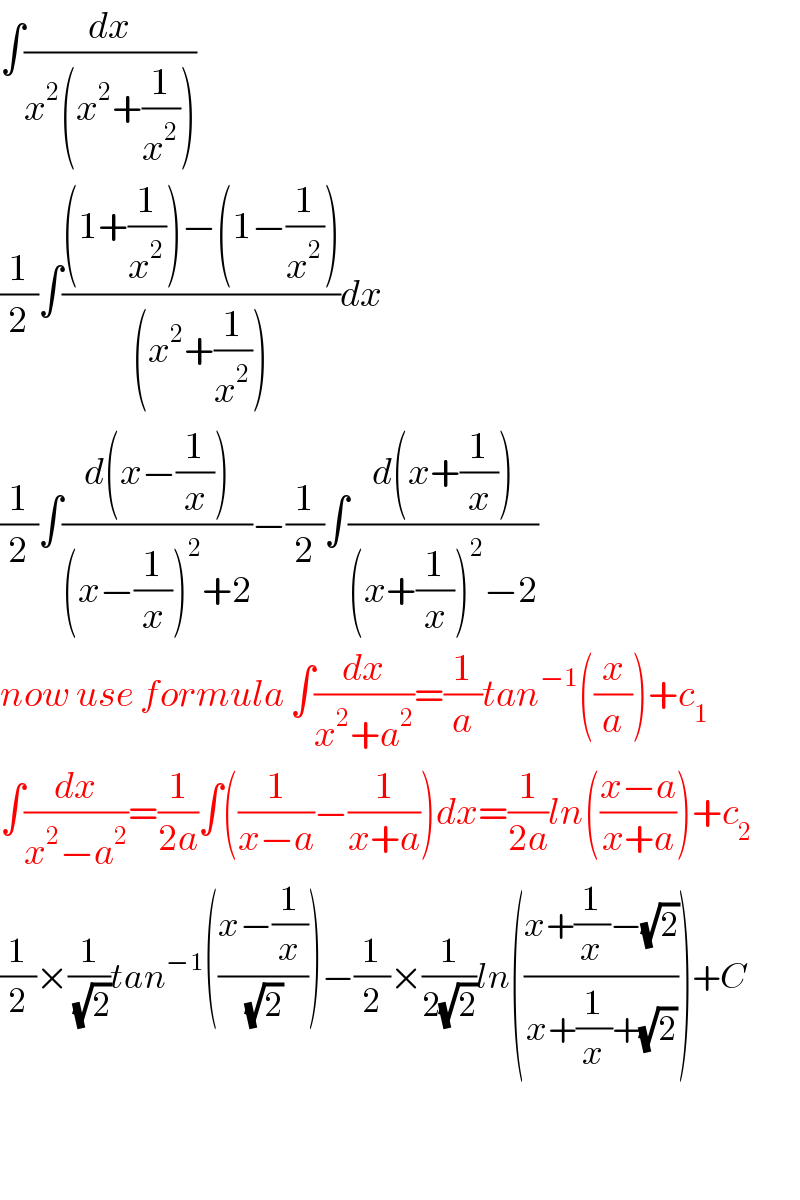
$$\int\frac{{dx}}{{x}^{\mathrm{2}} \left({x}^{\mathrm{2}} +\frac{\mathrm{1}}{{x}^{\mathrm{2}} }\right)} \\ $$$$\frac{\mathrm{1}}{\mathrm{2}}\int\frac{\left(\mathrm{1}+\frac{\mathrm{1}}{{x}^{\mathrm{2}} }\right)−\left(\mathrm{1}−\frac{\mathrm{1}}{{x}^{\mathrm{2}} }\right)}{\left({x}^{\mathrm{2}} +\frac{\mathrm{1}}{{x}^{\mathrm{2}} }\right)}{dx} \\ $$$$\frac{\mathrm{1}}{\mathrm{2}}\int\frac{{d}\left({x}−\frac{\mathrm{1}}{{x}}\right)}{\left({x}−\frac{\mathrm{1}}{{x}}\right)^{\mathrm{2}} +\mathrm{2}}−\frac{\mathrm{1}}{\mathrm{2}}\int\frac{{d}\left({x}+\frac{\mathrm{1}}{{x}}\right)}{\left({x}+\frac{\mathrm{1}}{{x}}\right)^{\mathrm{2}} −\mathrm{2}} \\ $$$${now}\:{use}\:{formula}\:\int\frac{{dx}}{{x}^{\mathrm{2}} +{a}^{\mathrm{2}} }=\frac{\mathrm{1}}{{a}}{tan}^{−\mathrm{1}} \left(\frac{{x}}{{a}}\right)+{c}_{\mathrm{1}} \\ $$$$\int\frac{{dx}}{{x}^{\mathrm{2}} −{a}^{\mathrm{2}} }=\frac{\mathrm{1}}{\mathrm{2}{a}}\int\left(\frac{\mathrm{1}}{{x}−{a}}−\frac{\mathrm{1}}{{x}+{a}}\right){dx}=\frac{\mathrm{1}}{\mathrm{2}{a}}{ln}\left(\frac{{x}−{a}}{{x}+{a}}\right)+{c}_{\mathrm{2}} \\ $$$$\frac{\mathrm{1}}{\mathrm{2}}×\frac{\mathrm{1}}{\:\sqrt{\mathrm{2}}}{tan}^{−\mathrm{1}} \left(\frac{{x}−\frac{\mathrm{1}}{{x}}}{\:\sqrt{\mathrm{2}}}\right)−\frac{\mathrm{1}}{\mathrm{2}}×\frac{\mathrm{1}}{\mathrm{2}\sqrt{\mathrm{2}}}{ln}\left(\frac{{x}+\frac{\mathrm{1}}{{x}}−\sqrt{\mathrm{2}}}{{x}+\frac{\mathrm{1}}{{x}}+\sqrt{\mathrm{2}}}\right)+{C} \\ $$$$ \\ $$$$ \\ $$
Commented by lémùst last updated on 31/Mar/20

$${thanks} \\ $$
Answered by redmiiuser last updated on 01/Apr/20
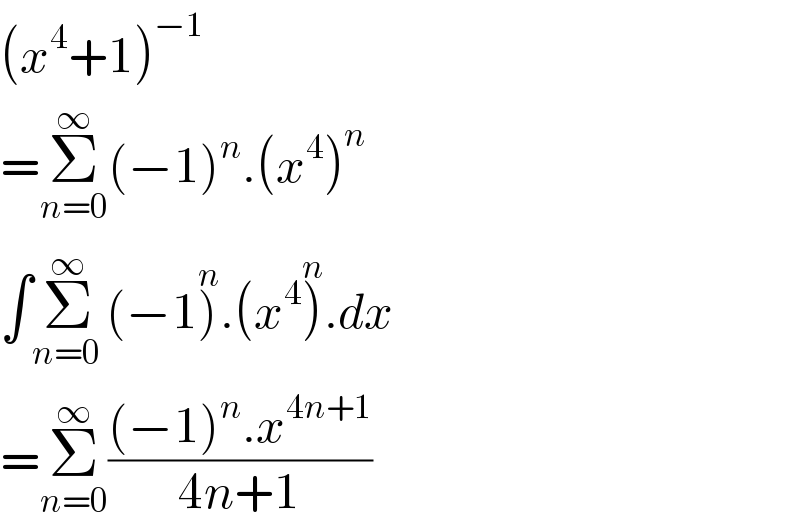
$$\left({x}^{\mathrm{4}} +\mathrm{1}\right)^{−\mathrm{1}} \\ $$$$=\underset{{n}=\mathrm{0}} {\overset{\infty} {\sum}}\left(−\mathrm{1}\right)^{{n}} .\left({x}^{\mathrm{4}} \right)^{{n}} \\ $$$$\int\underset{{n}=\mathrm{0}\:} {\overset{\infty} {\sum}}\left(−\mathrm{1}\overset{{n}} {\right)}.\left({x}^{\mathrm{4}} \overset{{n}} {\right)}.{dx} \\ $$$$=\underset{{n}=\mathrm{0}} {\overset{\infty} {\sum}}\frac{\left(−\mathrm{1}\right)^{{n}} .{x}^{\mathrm{4}{n}+\mathrm{1}} }{\mathrm{4}{n}+\mathrm{1}} \\ $$
Commented by redmiiuser last updated on 01/Apr/20

$$\left({x}^{\mathrm{4}} +\mathrm{1}\right)^{−\mathrm{1}} \\ $$$${can}\:{be}\:{expanded}\:{by} \\ $$$${Talyors}\:{formula}. \\ $$
